Gus Grissom
| Virgil Ivan "Gus" Grissom | |
|---|---|
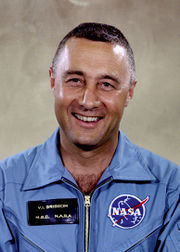 |
|
| NASA Astronaut | |
| Nationality | American |
| Status | Died during a plugs-out test of the AS-204 Command Module |
| Born | April 3, 1926 Mitchell, Indiana |
| Died | Cape Canaveral, Florida |
| Other occupation | Test pilot |
| Rank | Lieutenant Colonel, USAF |
| Time in space | 5h 7m |
| Selection | 1959 NASA Group |
| Missions | Mercury-Redstone 4, Gemini 3, Apollo 1 |
| Mission insignia |
|
Virgil Ivan Grissom, widely noted as Gus Grissom (April 3, 1926 – January 27, 1967) was one of the original NASA Project Mercury astronauts and a United States Air Force pilot. He was the second American to fly in space and the first person to fly in space twice. Grissom was killed along with fellow astronauts Ed White and Roger Chaffee during a pre-launch test for the Apollo 1 mission at the Kennedy Space Center. He was a recipient of the Distinguished Flying Cross and, posthumously, the Congressional Space Medal of Honor.
Contents |
Family and background
Grissom was born in Mitchell, Indiana on April 3, 1926, the second child of Dennis and Cecile King Grissom.[1] His father was a signalman for the Baltimore and Ohio Railroad, and his mother a homemaker. His older sister died shortly before his birth, and he was followed by three younger siblings, Wilma, Norman and Lowell.[2] As a child he attended the local Church of Christ where he remained a lifelong member and joined the Boy Scouts' Troop 46. He was enrolled in public elementary schools and went on to attend Mitchell High School. Grissom met and befriended Betty Lavonne Moore at school through their extracurricular activities.[3] He worked delivering newspapers for the Indianapolis Star and in a local meat market for his first jobs.[4]
Grissom occasionally spent time at a local airport in Bedford, Indiana where he first became interested in flying. A local attorney who owned a small plane would take him on flights for a $1 fee and taught him the basics of flying an airplane.[5] World War II broke out while Grissom was still in highschool, and he was eager to enlist upon graduation. Grissom enlisted as an aviation cadet in the United States Army Air Forces and completed an entrance exam in November 1943. He graduated from high school in 1944 and was inducted into the army at Fort Benjamin Harrison on August 8, 1944.[6] He was sent to Sheppard Field in for basic training after which he was assigned as a clerk at Brooks Field in .[7]
As the war neared its end, Grissom sought to be discharged. He married Betty Moore on July 6, 1945 while on leave, and secured his discharge in September.[8] He took a job in carpentry at a local business and rented an apartment in Mitchell. He had trouble providing a sufficient income and was determined to attend college. He took advantage of the G.I. Bill for partial payment of his school tuition and enrolled at Purdue University in September 1946.[9] During his time in college Betty returned to live with her parents and took a job at the Indiana Bell Telephone Company while he worked part time as a cook at a local restaurant.[10] Grissom took summer classes to finish early and graduated with a bachelor of science degree in mechanical engineering in 1950.[11]
Korean War
Grissom re-enlisted in the newly formed United States Air Force after his graduation from Purdue. He was accepted into the air cadet basic training program at Randolph Air Force Base in . Upon completion of the program, he was assigned to Williams Air Force Base in .[12] In March 1951 Grissom received his pilot wings and commission as a Second Lieutenant.[13] Grissom's wife remained in Indiana and while he was away his first child was born, Scott. After his birth they joined Grissom at his new post in Phoenix, Arizona.[14] The family remained there only briefly and in December 1951 they moved to Presque Isle, Maine where Grissom became a member of the Seventy-Fifth Fighter Interceptor Squadron.[15]
With the ongoing Korean War, Grissom's squadron was dispatched to the war zone in February 1951. There he flew as an F-86 Sabre replacement pilot and was reassigned to the 334th Fighter Squadron of the 4th Fighter Interceptor Wing stationed at Kimpo Air Base.[16] Grissom flew 100 combat missions during his time in the war, serving as a wingman protecting the lead fighters. The position was not one that put him in a position to attack the enemy and he did not shoot down any planes while he was in service. He did personally drive off Korean air raids on multiple occasions; their MIGs would often flee at the first sign of superior American aircraft.[17] On March 11, 1952, Grissom was promoted to First Lieutenant and was cited for his "superlative airmanship".[18]
Grissom requested to remain in Korea to fly another 25 flights, but his request was denied. He was given the option of which base he would like to be stationed at in the United States and he requested the Bryan AFB in . There he served as a flight instructor, and was joined by his wife and son. His second child was born in Bryan in 1953.[19] During a training exercise with a cadet, a trainee pilot caused a flap to break off the plane, causing it to spin out of control. Grissom climbed from the rear seat of the small craft to take over the controls and safely land the jet.[20]
In August 1955 Grissom was reassigned to the US Air force Institute of Technology located in Dayton, Ohio. There he earned a bachelors degree in aero mechanics after completing a year-long course.[21] In October 1956, he entered the test pilot school at Edwards Air Force Base, California and returned to Wright-Patterson in May 1957 as a test pilot assigned to the fighter branch.[22][23]
Astronaut
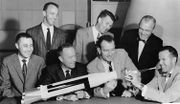
As an Air Force captain in 1959 Grissom underwent a series of physical and psychological tests and was then chosen as one of the seven Project Mercury astronauts.[24]
Liberty Bell 7
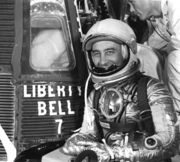
In 1961, Grissom was pilot of Mercury-Redstone 4, popularly known as Liberty Bell 7, the second American (suborbital) spaceflight. After splashdown explosive bolts blew the hatch off unexpectedly and water flooded into the tiny capsule. Grissom exited through the open hatch and into the ocean but nearly drowned as water filled his flightsuit while a helicopter tried to lift and recover the spacecraft. The capsule became too heavy with water and sank. Grissom strongly asserted he had done nothing to blow the hatch and NASA officials eventually concluded that he was correct. Initiating the explosive egress system required hitting a metal trigger with the side of a closed fist. This would always leave a large, obvious bruise on the astronaut's forearm, but Grissom was found not to have any of the tell-tale bruising associated with triggering the emergency hatch release. The capsule was recovered in 1999 but no evidence was found which could conclusively explain how the explosive hatch release fired on its own. Years after, Guenter Wendt (who was pad leader for the early American manned space launches) wrote that he believed a small cover over the external release actuator was accidentally lost sometime during the flight or splashdown and the T-handle may have been tugged by a stray parachute shroud line, or was perhaps damaged by the heat of re-entry, cooled upon splashdown, contracted and then fired.[24][25]
Grissom was surrounded by reporters in a news conference after his space flight in America's second manned ship. When asked how he felt, he replied, "Well, I was scared a good portion of the time; I guess that's a pretty good indication."[26]
Gemini 3
In early 1964 Alan Shepard was grounded after being diagnosed with Ménière's disease and Grissom was designated command pilot for Gemini 3, the first manned Project Gemini flight. This mission would make him the first astronaut to fly twice beyond the accepted boundary of space. Grissom was one of the smaller-sized astronauts, and he worked very closely with the engineers and technicians from McDonnell Aircraft who built the Gemini capsule. The first three spacecraft were built around him and the design was humorously named the Gusmobile. However by July 1963 NASA discovered 14 out of the 16 astronauts could not fit themselves into the cabin and later cockpits were modified.[27] During this time Grissom innovated a multi-axis joystick for controlling the maneuvering thrusters with one hand.
Naming of the Molly Brown
In a joking nod to the sinking of his Mercury craft Grissom named the first Gemini capsule the Molly Brown after the popular Broadway show The Unsinkable Molly Brown but NASA publicity officials were unhappy with this name. When Grissom and his pilot John Young were ordered to come up with a new one they offered The Titanic. Aghast, NASA executives gave in and allowed the name Molly Brown but didn't use it in any official references. Subsequently and much to the agency's chagrin, on launch CAPCOM Gordon Cooper gave Gemini 3 its sendoff by saying over the uplink, "You're on your way, Molly Brown!" and ground controllers used this name throughout the flight.
After the safe return of Gemini 3 NASA announced new spacecraft would not be named. Hence Gemini IV was not named American Eagle as planned. The naming of spacecraft resumed in 1967 after managers found the Apollo flights needed a name for each of two flight elements, the command module and lunar module. Lobbying by the astronauts and senior NASA administrators also had an effect. Apollo 9 had the callsigns Gumdrop for the command module and Spider for the lunar module. However, Wally Schirra had been prevented from naming his Apollo 7 spacecraft the Phoenix in honor of Grissom's Apollo 1 crew since it was believed the average taxpayer would not take a "fire" metaphor as intended.
Death
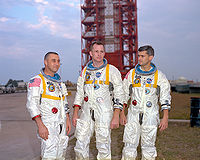
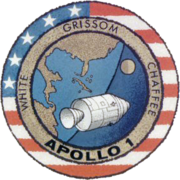
Grissom was backup command pilot for Gemini 6A when he shifted to the Apollo program and was assigned as commander of AS-204, which was meant to be the first manned Apollo flight. He was killed along with fellow astronauts Ed White and Roger B. Chaffee when the Apollo 1 command module caught fire and burned on Launch Pad 34 during a pre-launch test at Cape Kennedy on January 27, 1967. The fire's ignition source was never determined, but their deaths were attributed to a wide range of lethal design hazards in the early Apollo command module, such as its highly pressurized 100% oxygen atmosphere during the test, many wiring and plumbing flaws, flammable materials in the cockpit, a hatch which might not open at all in an emergency, and even the flight suits worn by the astronauts.[28] After the tragedy, these, along with other flaws and design problems, were fixed so the Apollo program could carry on successfully.
Grissom was a Lieutenant Colonel at the time of his death, and he had logged a total of 4,600 hours flying time, including 3,500 hours in jet airplanes. In his 1994 autobiography Deke!, the chief astronaut Deke Slayton said he wanted one of the original Mercury Seven astronauts to be the first on the moon and, "Had Gus been alive, as a Mercury astronaut he would have taken the step." Slayton also wrote, "My first choice would have been Gus, which both Chris Kraft and Bob Gilruth seconded."
Gus Grissom is buried in Section 3 (GPS Coordinates: 38.873115 N, -77.072755 W) of the Arlington National Cemetery, near Roger Chaffee. Ed White is buried at the West Point Cemetery, West Point, New York.
Spacesuit controversy
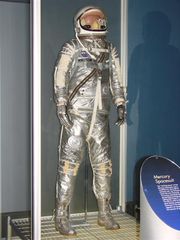
When the Astronaut Hall of Fame opened in 1990 his family loaned it the spacesuit worn by Grissom during Mercury 4 along with other personal artifacts belonging to the astronaut. In 2002 the museum went into bankruptcy and was taken over by a NASA contractor, whereupon the family asked for everything back.[29] All the artifacts were returned to them except the spacesuit, which NASA claimed was government property.[30] NASA insisted Grissom got authorization to use the spacesuit for a show and tell at his son's school and never returned it but some Grissom family members claimed the astronaut rescued the spacesuit from a scrap heap.[31]
Awards and honors
- Distinguished Flying Cross for service in Korea
- Air Medal with cluster for service in Korea
- Two NASA Distinguished Service Medals
- NASA Exceptional Service Medal
- Air Force Command Pilot rating with astronaut qualifier
- Honorary Doctorate, Florida Institute of Technology
- Congressional Space Medal of Honor, 1978 (posthumous)
- Honorary Mayor of Newport News, Virginia (posthumous)
- Enshrined at the "Wall Of Honor" at the Steven F. Udvar-Hazy Center (Smithsonian) at Washington Dulles International Airport
Memorials
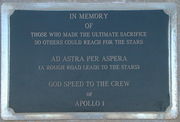
- Grissom is named with his fellow Apollo 1 crewmates on the Space Mirror Memorial at John F. Kennedy Space Center in Florida.
- Navi (Ivan backwards), a star also named Gamma Cassiopeiae: Grissom and one of his flight crews had used the star to calibrate their equipment, wrote the name in logs as a joke and it eventually stuck.[32][33]
- Grissom Hill is 7.5 km (4.7 mi) southwest of Columbia Memorial Station on Mars and is one of the Apollo 1 Hills.
- A landmark on the moon is called Marina Grissom.
- Gus Grissom's boyhood home on Grissom Avenue (renamed in his honor after his Mercury flight[34]) in Mitchell, Indiana, is currently being restored into a museum.
- A limestone carving of the Titan II rocket which launched the Gemini flight is in downtown Mitchell, Indiana. There is also a memorial in nearby Spring Mill State Park.
- Grissom attended Mitchell High School and its auditorium is named for him.
- Virgil I. Grissom Library, Denbigh section of Newport News, Virginia.
- Virgil I. Grissom Bridge across the Hampton River, on Rt 258 (Mercury Blvd, named after the Mercury program) in Hampton, VA, is one of the six bridges and one road named after the original 7 Mercury astronauts, who trained in the area.
- Virgil "Gus" Grissom Park, Fullerton, California. (Fullerton also has parks named for White and Chaffee).[35]
- The Gus Grissom Stakes, thoroughbred horse race run each fall at Hoosier Park in Anderson, Indiana.
- Grissom Island, artificial island, Long Beach Harbor off Southern California [36][37].
- Grissom Hall, a dormitory at State University of New York at Fredonia.
Military
- Bunker Hill Air Force Base in Peru, Indiana, was renamed on May 12, 1968, to Grissom Air Force Base. In 1994 it was again renamed to Grissom Air Reserve Base following the USAF's realignment program.[38]
- Grissom Dining Facility, Misawa Air Base, Japan.
- Grissom was the "Class Exemplar" of the United States Air Force Academy class of 2007.
- Grissom Hall at Purdue University was the home of the School of Aeronautics and Astronautics for several decades and is still in use as an engineering building today.
- Grissom Hall at the former Chanute Air Force Base, Rantoul, Illinois, where Minuteman missile maintenance training was covered.
Schools
- Grissom Hall, an engineering building at Purdue University, his alma mater.[39]
- Grissom Hall, Florida Institute of Technology.
- Grissom Hall, State University of New York at Fredonia.
- Virgil I. Grissom High School, Huntsville, Alabama.[40] (Huntsville also has schools named for Roger Chaffee, Ed White, and the lost space shuttles: Roger B. Chaffee Elementary School, Ed White Middle School, Challenger Middle School, and Columbia High School)[41]
- Virgil I. Grissom Middle School, Mishawaka, Indiana.
- Virgil I. Grissom Middle School, Tinley Park, Illinois.
- Virgil I. Grissom Middle School, Sterling Heights, Michigan.
- Virgil I. Grissom Junior High School 226, South Ozone Park, Queens, New York City, New York.
- Virgil I. Grissom Elementary School, Houston.[42]
- Virgil Grissom Elementary School, Old Bridge, New Jersey. This school was named for Grissom several years before his death.[43]
- Virgil I. Grissom Elementary School, Hegewisch, Illinois.
- Grissom Elementary School, Gary, Indiana.
- Virgil Grissom Elementary School, Princeton, Iowa.
- Grissom Elementary School, Tulsa, Oklahoma.
- Virgil I. Grissom School No. 7, Rochester, New York.
- V.I. Grissom Elementary School, formerly at Clark Air Base, Philippines (Base and school are now closed).
- Grissom Elementary School, Muncie, Indiana.
Film and television
Grissom has been noted and remembered in many film and television productions. Before he became widely known as an astronaut, the film Air Cadet (1951) starring Richard Long and Rock Hudson briefly featured Grissom early in the movie as a U.S. Air Force candidate for flight school at Randolph Field, San Antonio, Texas. Grissom was depicted by Fred Ward in the film The Right Stuff (1983) and (very briefly) in the film Apollo 13 (1995) by Steve Bernie. He was portrayed in the TV mini-series From the Earth to the Moon (1998) by Mark Rolston. Actor Kevin McCorkle played Grissom in the third season finale of the NBC television show American Dreams. Bryan Cranston played Grissom as a nervous variety-show guest in the film That Thing You Do!
In the film Star Trek III: The Search for Spock the Federation starship sent to survey the newly formed Genesis Planet is named USS Grissom, a second starship in Star Trek: The Next Generation is also said to be called USS Grissom. The character Gus Griswald in the popular children's TV show Recess is named after Grissom (his fictional father is a General in the US Army and Gus is his recruit). The character Gil Grissom in the CBS television series CSI: Crime Scene Investigation[44] and the character Virgil Tracy in the British television series Thunderbirds are named after the astronaut. NASA footage including Grissom's Mercury, Gemini, and Apollo missions was released in high definition on the Discovery Channel in June 2008 in the television series When We Left Earth: The NASA Missions.[24]
Books
A family-approved account of Grissom's life appears in the 2003 book Fallen Astronauts by Colin Burgess and Kate Doolan. Ray E. Boomhower wrote a biography of Grissom titled Gus Grissom: The Lost Astronaut in 2004, published by the Indiana Historical Society Press. Betty Grissom wrote a memoir titled Starfall in 1974.
Grissom died while putting the finishing touches on Gemini!, his account of the Gemini Program, in which he was heavily involved. The final chapter is dated January 1967, a few days before Grissom's death on the Apollo launch pad. According to editor Jacob Hay, the book's final form was "reached with the approval of Mrs. Betty Grissom."
Quotation
| “ | If we die, we want people to accept it. We are in a risky business and we hope that if anything happens to us it will not delay the program. The conquest of space is worth the risk of life. | ” |
-
-
-
-
-
-
-
-
- - after the Gemini 3 mission, March 1965
-
-
-
-
-
-
-
References
- ↑ Boomhower, p. 39
- ↑ Boomhower, p. 40
- ↑ Boomhower, pp. 43–45
- ↑ Boomhower, p. 42
- ↑ Boomhower, p. 47
- ↑ Boomhower, p. 48
- ↑ Boomhower, p. 49
- ↑ Boomhower, p. 50
- ↑ Boomhower, p. 52
- ↑ Boomhower, p. 55
- ↑ Boomhower, p. 56
- ↑ Boomhower, p. 57
- ↑ Boomhower, p. 58
- ↑ Boomhower, p. 59
- ↑ Boomhower, p. 60
- ↑ Boomhower, p. 63
- ↑ Grissom, p. 66
- ↑ Grissom, p. 67
- ↑ Boomhower, p. 68
- ↑ Boomhower, p. 69
- ↑ Boomhower, p. 71
- ↑ "Astronaut Biographies: Virgil I. (Gus) Grissom". U.S. Astronaut Hall of Fame. http://www.astronautscholarship.org/grissom.html. Retrieved January 23, 2008.
- ↑ "Astronaut Bio: Virgil I. Grissom". Lyndon B. Johnson Space Center. http://www.jsc.nasa.gov/Bios/htmlbios/grissom-vi.html. Retrieved June 11, 2008.
- ↑ 24.0 24.1 24.2 Discovery Channel, When We Left Earth: The NASA Missions, "Ordinary Supermen," airdate June 8, 2008 (season 1)
- ↑ Banke, Jim (June 17, 2000). "Gus Grissom didn't sink the Liberty Bell 7 Mercury capsule". space.com. http://www.space.com/missionlaunches/missions/liberty_bell_000617.html. Retrieved December 26, 2008.
- ↑ "Year in Review". UPI.com. http://www.upi.com/Audio/Year_in_Review/Events-of-1961/12295509433760-1/#title.
- ↑ Hacker, Barton C.; James M. Grimwood (1977). On the Shoulders of Titans: A History of Project Gemini. NASA History Series #4203. NASA Special Publications. http://www.hq.nasa.gov/office/pao/History/SP-4203/ch10-2.htm. Retrieved January 23, 2008.
- ↑ "Findings, Determinations And Recommendations". Report of Apollo 204 Review Board. NASA. April 5, 1967. http://www.hq.nasa.gov/office/pao/History/Apollo204/find.html. "No single ignition source of the fire was conclusively identified."
- ↑ Kelly, John (November 20, 2002). "Gus Grissom's Family, NASA Fight Over Spacesuit". Florida Today. http://www.space.com/news/grissom_spacesuit_021120.html. Retrieved May 27, 2007.
- ↑ "Luckless Gus Grissom in the hot seat again". RoadsideAmerica.com. November 24, 2002. http://www.roadsideamerica.com/tnews/NewsItemDisplay.php?Tip_AttrId==7014. Retrieved May 4, 2007.
- ↑ Lee, Christopher (August 24, 2005). "Grissom Spacesuit in Tug of War". Washington Post. http://www.washingtonpost.com/wp-dyn/content/article/2005/08/23/AR2005082301204_pf.html. Retrieved May 27, 2007.
- ↑ Wasik, John W. (April 4, 1965). "Virgil Grissom and John Young: Our Trail-Blazing "Twin" Astronauts". Family Weekly (The Herald-Tribune): p. 4. http://news.google.com/newspapers?nid=1774&dat=19650404&id=AZscAAAAIBAJ&sjid=wmUEAAAAIBAJ&pg=5001,1212947. Retrieved January 28, 2010.
- ↑ "Parks & Recreation: List of parks". City of Fullerton. http://www.cityoffullerton.com/depts/parks_n_recreation/find_a_park/list_of_parks.asp. Retrieved June 11, 2008.
- ↑ Fallen Astronaut
- ↑ pdf of City of Long Beach Economic Zones
- ↑ "Questions About Grissom". Grissom Air Reserve Base, USAF. http://www.grissom.afrc.af.mil/questions/. Retrieved January 23, 2008.
- ↑ Sequin, Cynthia (October 14, 2005). "Purdue industrial engineering kicks off Grissom renovation, celebrates gifts". Purdue University News. http://news.uns.purdue.edu/UNS/html3month/2005/051014.Celebrate.iegifts.html. Retrieved January 23, 2008.
- ↑ "Grissom High School". WikiMapia. http://www.wikimapia.org/#y=34661558&x=-86536501&z=17&l=0&m=h. Retrieved January 23, 2008.
- ↑ Jaques, Bob (June 6, 2002). "First spacewalk by American astronaut 37 years ago" (PDF). Marshall Star (NASA Marshall Space Flight Center): p. 5. http://marshallstar.msfc.nasa.gov/6-6-02.pdf.
- ↑ "Mission Control". Virgil I. Grissom Elementary School. Houston ISD. http://es.houstonisd.org/grissomes/MISSION%20CONTROL.htm. Retrieved July 27, 2009.
- ↑ "Welcome to Virgil Grissom Elementary School". Old Bridge Township Public Schools. http://www.oldbridgeschools.org/grissom/. Retrieved January 23, 2008.
- ↑ Zaslow, Jeffrey (January 20, 2002). "A real reality show; William Petersen, star of CBS' surprise hit series CSI seeks ultimate truths in some unseemly places". USA Weekend. http://www.usaweekend.com/02_issues/020120/020120petersen.html. Retrieved January 23, 2008.
External links
- Gus Grissom - I Knew Him
- Indiana Historical Society tribute to Gus Grissom
- Detailed Biographies of Apollo I Crew - Gus Grissom - NASA
- NASA biography
- Grissom page at Astronaut Memorial Foundation
- Spacefacts biography
- Roadside America review of Grissom Museum
- Virgil Ivan Grissom Photographs of grave site, Arlington National Cemetery along with other photographs and a brief biography.
- Gus Grissom at Find a Grave Retrieved on 2009-5-20
|
||||||||
|
|||||||||||||